Introduction
The potential for recording seismic data in forestry areas of Canada using novel weight drop systems has been examined. Some methods tested yielded data which is comparable with conventional dynamite data, but at potentially less cost, with the additional benefit of minimizing any environmental impact. The impact energy for a source point was increased by increasing either the drop height “high altitude weight drop” or accelerating the weight under force greater than that of gravity alone “accelerated weight drop”. In this paper we compare the results of two different weight drop systems and highlight the potential benefits of both.
Background
Using a dropped weight as a seismic source is not new. Many people will remember systems that dropped a 3 ton weight mounted on the back of a large truck. The weight could be lifted to a height of approximately 10 feet and dropped. Weight drop systems have largely been replaced with dynamite and Vibroseis sources for land exploration, and in Canada dynamite has usually prevailed as the source of choice due in part to access problems associated with Vibroseis. Dynamite sources have the capability of generating a far larger source signal than traditional weight drop sources, but an increase in the seismic energy of a weight drop system can be achieved in several ways:
- Repeating the drop more times.
- Dropping a larger weight.
- Dropping the weight from a greater height.
- Accelerating the weight under a force greater than that of gravity.
Options 3 and 4 offer some potential for further examination, and these options were examined as part of a source test conducted in Canada during the winter season of 2000/2001.

Theory
If we assume that the signal imparted to the ground from a weight drop system stems from the (perfect) conversion of the kinetic energy of the mass when it hits the ground, then we can compute some benchmarks for weight drop systems.
As a basis for comparison we will assume that a conventional system uses a 3 ton weight which is dropped under the force of gravity a distance of 10 feet, The energy generated by such a source (while something of a mis-match in units) is approximately 81 kJoules. So initially we can look at what heights and weights would yield equivalent energy. Table 1: Impact Energy from ice sphere, shows the height required for a drop of a falling weight in order to generate the same kinetic energy as our reference 3 ton weight from falling from 10 feet, if acceleration due to gravity is not affected by drag.
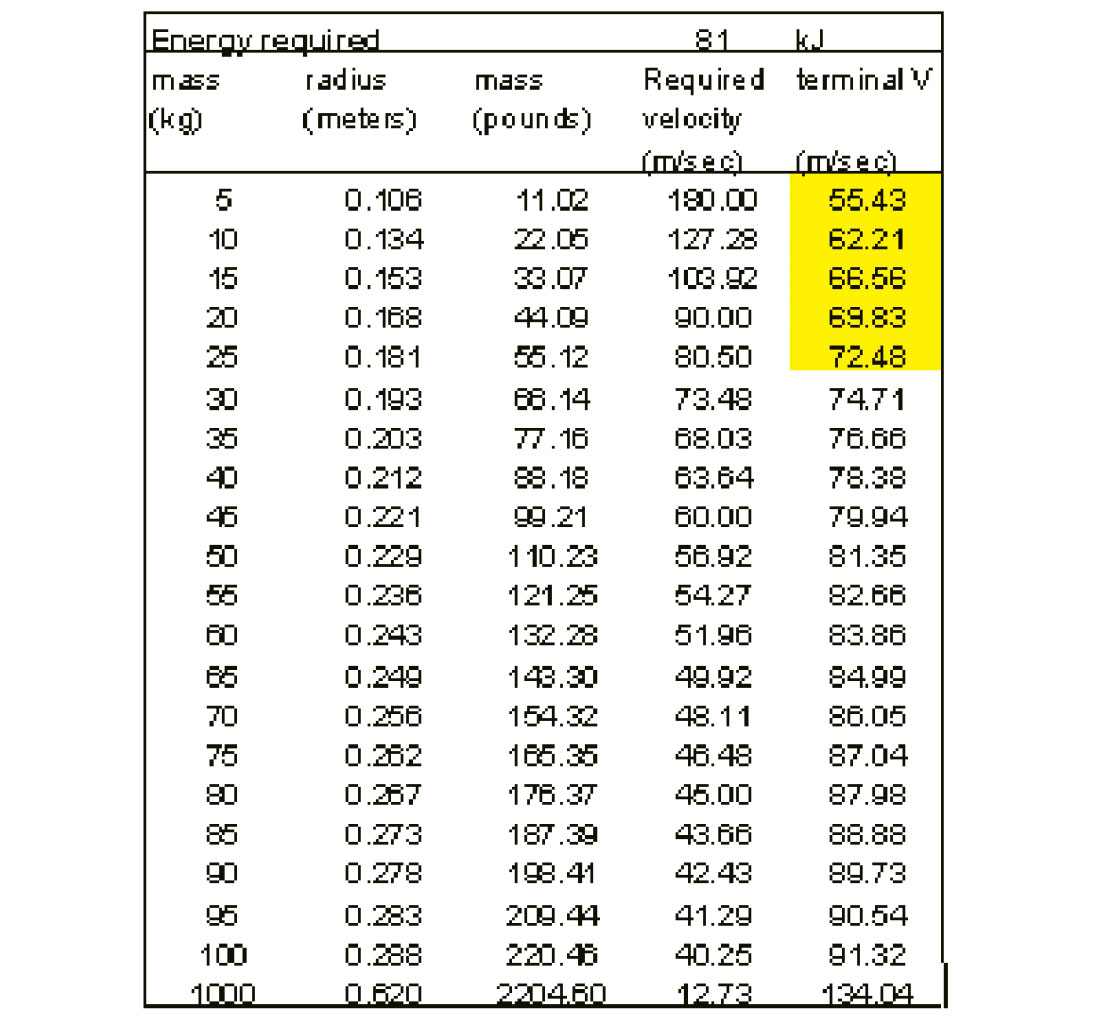
Note that of course the relationship between required weight and drop height to achieve a particular level of kinetic energy is linear in log/log space (in the absence of drag) as it has a dependence on velocity squared. An order of magnitude reduction in weight requires an order of magnitude increase in altitude to achieve the same result. So a 6000lb weight (3 tons) dropped from 10 feet yields equivalent energy to a 600 lb. weight dropped from 100 feet, or a 60 lb. weight dropped from 1000 feet, so large impact energy is possible with relatively small weights.
The detail of the weight curve suggests that if drop heights of 1000 feet or more were possible, then relatively small, manageable weights could apparently be used to yield the same impact energy as very large weights on the back of a surface located system.
While the dragless case is approximately correct for very large weights falling only a relatively small distance, as drop height increases the effect of air resistance needs to be evaluated as the falling weight will start to be effected by drag. Various realistic weight types including balls of ice, and steel pipes have been examined.
Table 1 shows the relationship between mass and radius for a series of ice balls, and the velocity required to gain kinetic energy of 81 kJ, compared to the terminal velocity of the object. Note that for weights of less than (approximately 50 lb.), it is not possible to generate the required 81 kJoules of kinetic energy (highlighted in the table), as the terminal velocity for these weights is less than the velocity required. No matter what altitude the weight is dropped from, the impact energy will be less than 81 kJoules.
Note here that while the selection of 81 kJoules is somewhat arbitrary, it does at least allow comparison with a conventional source and give the reader some idea of the potential signal strength.
For any given weight it is of course possible to evaluate the impact energy that will be generated from a drop from any given altitude. Efficiency diminishes as higher altitudes are reached as the drop weight begins to reach terminal velocity as it falls through the air. The terminal velocity is dependent on the density of the material used and the shape of weight, and faster terminal velocities (and therefore bigger impact energy) are possible with denser material and more aerodynamic weights.
Environmental impact potential
Seismic exploration in some areas is only possible with some impact to the local environment. Over the course of many years, continuing seismic activity can lead to problems in obtaining further permits and permissions because of the effects on the environment of older seismic activity. Figure 2 shows a photograph of some of the cut lines through forestry in an area of Northern Alberta. While some of these lines are cut for lumber harvest, many of them are shot and receiver lines for 2D and 3D seismic exploration. It would of course be desirable if the width and number of these lines could be reduced while still performing adequate seismic exploration.
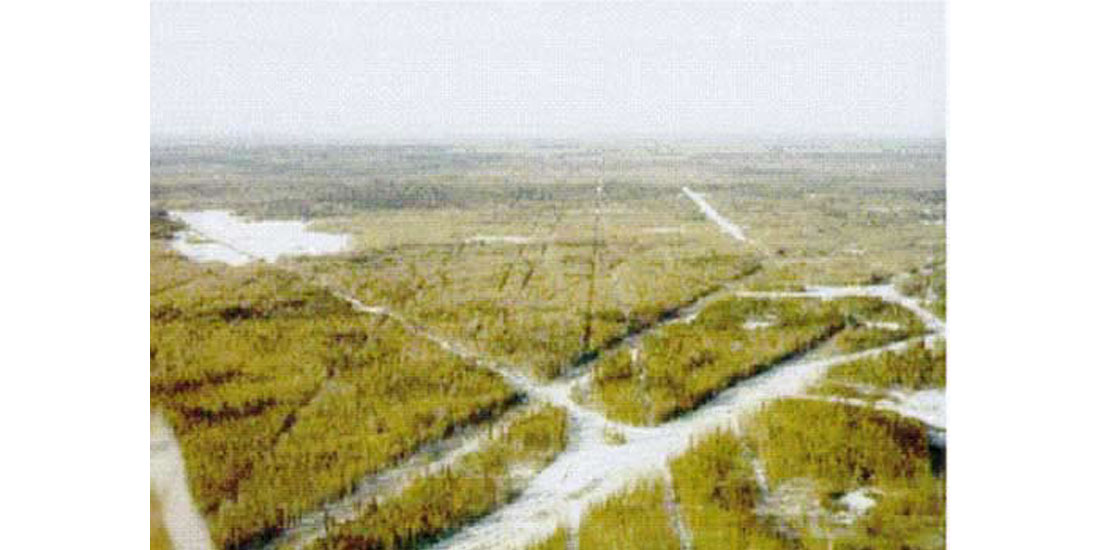
High altitude weight drop systems offer the potential for considerable reduction in environmental impact for several reasons. Firstly, there may be no requirement to cut access lines for shot points. If drop positions can be determined either from GPS at the time of drop, or at a later stage (either from the air, or by inspection of the recorded data), then there may be no requirement for surface access at all. If the weights that are dropped can be made of a bio-degradable or bio-friendly material (for example blocks of ice) then there would be no requirement to retrieve the source weights, which could be left to thaw. The result could potentially be a survey in which no surface access is required at all for source points. This would certainly minimize the environmental impact of seismic exploration in these areas.
Weight drop tests
Having identified a suitable test location, a series of conventional dynamite source tests were conducted along with both high altitude weight drop and accelerated surface based weight drop tests. The test site was at the intersection of shot and receiver lines in the 3D survey, but had been additionally cleared to a larger area than normal. The site was well clear of roads, pipelines, and all other potential hazards on the surface.
High altitude drop tests were performed using a helicopter normally used for moving equipment around the project. It was possible to attach a variety of purpose built weights, and release these individually over the desired target area. The largest single impact achieved utilized a 200 lb. weight from a height of 2000 feet, which was predicted to yield energy equivalent to more than 6 repetitions of a conventional 3 ton weight drop from 10 feet (close to 500 kJ).
Weights were dropped in sequence from lower altitude to higher with increasing weight. This sequence was established to ensure that any potential safety issues were examined with the smallest weight from the lowest altitude first. The helicopter was equipped with GPS positioning, and the location of the target was known. The initial drop of a 50 lb. weight from an altitude of 500 feet landed within inches of the target. In each case drift calculations were performed before the drop based on helicopter reported wind.
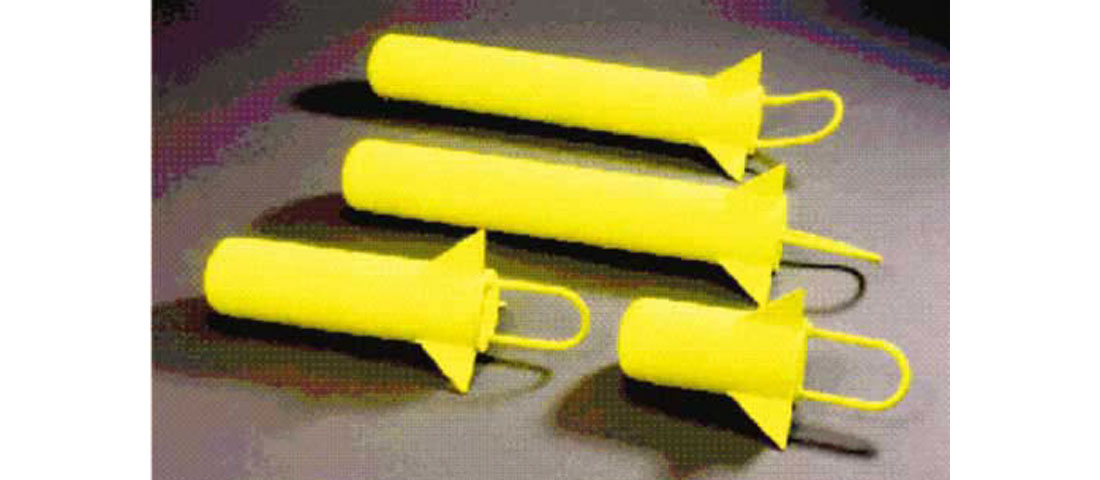
The tests of the high altitude drops produced records which were much as expected, in that the S/N improved with predicted impact energy. Data was recorded in each case into a full active spread from the 3D that was being acquired (a minimum of 594 live channels). Drop time differences were treated as simple static corrections as the actual drop and impact time were controlled manually during the tests, and varied from record to record.
All impacts produced records with readily identifiable first breaks on all traces. A comparison between the lightest impact and heaviest impact shows a distinct increase in energy and improvement in S/N. Target times in this area are relatively shallow, down to 1.1 seconds. Important reflectors are between 800 msec and 1.1 seconds. S/N on some of the high altitude weight drop records was a problem initially, as one of the biggest noise sources was the helicopter itself. No attempt has been made to remove this noise while evaluating the data in the field, which was particularly bad for lower altitude drops, clearly this would be an issue for a production system for drop altitudes less than 1000 feet. Figure 4 shows the spectrum of data from one of the lower altitude drop tests. The dominant spikes in the spectrum are from the helicopter noise. The upper limit to the frequency content appears to be related to the high cut filter of the recording system.
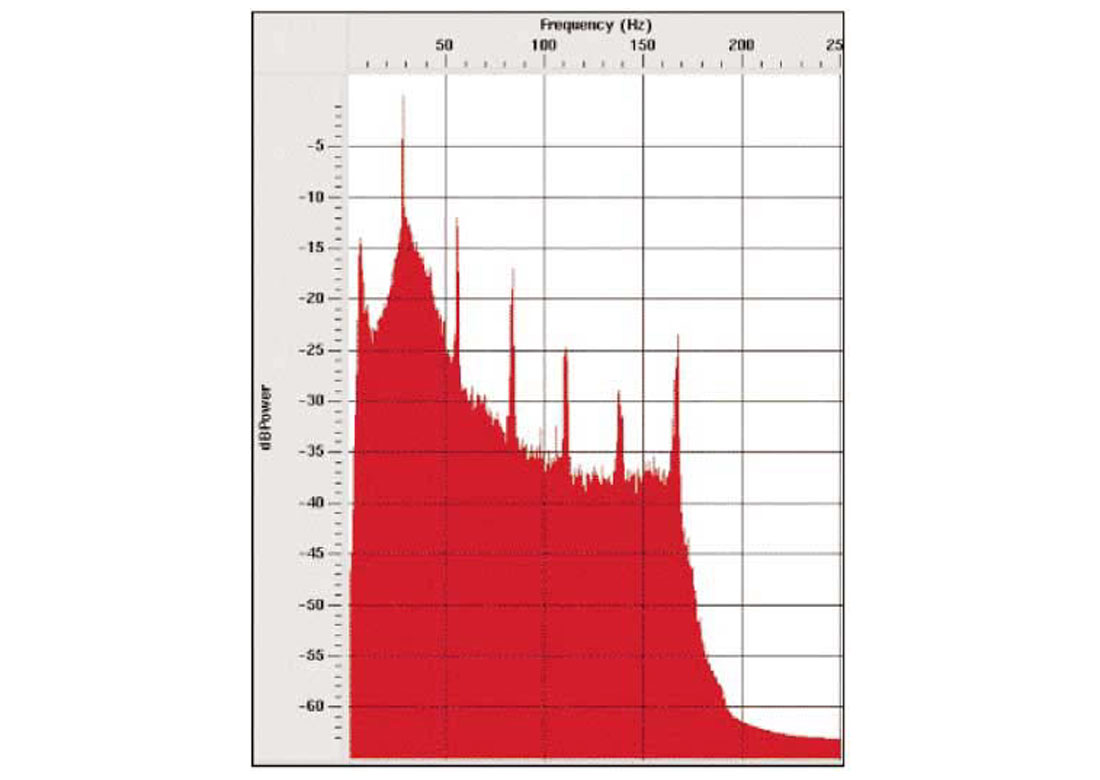
Subsequent processing of the weight drop records suggested that the helicopter noise could be easily removed as it exhibited very discrete frequency content associated with the blade rotation of the helicopter. Simple spiking decon was an effective noise removal process.
Prior to the test, it was anticipated that some of the weights would not be retrievable because they would bury into the ground. The ground condition at the test site was hard packed frozen clay, and in fact none of the weights buried into the ground to any distance. Typical “ground damage” was very localized, with less than 1” of compaction of the surface. One of the drops was reported to have “bounced” by observers. The bounce was estimated at over 30’, suggesting considerable resilience of the surface. Close examination of some records suggests a second set of arrivals, which may well be related to a subsequent ground impact after bouncing.
In addition to the high altitude weight drop tests, a series of surface accelerated weight drop records were recorded using a system supplied by Polaris Exploration. This system utilized a weight plate of approximately 550 lbs raised 2 feet above the ground using hydraulics. The system is shown in Figure 5. The additional force from a rubber band (jacked up with hydraulics) accelerates the weight so that it has an impact velocity of approximately 15 m/sec. Each impact of the accelerated weight drop therefore has energy of approximately 30 kJ.
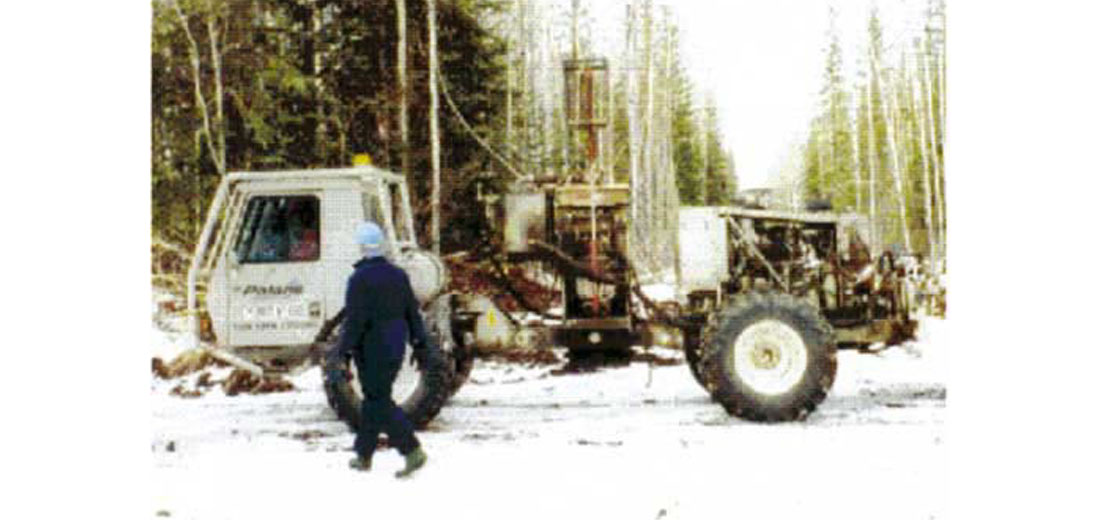
The accelerated weight drop system also suffered from some initial unanticipated practical problems (the timing of individual records was achieved manually), but records made using the accelerated weight drop system were very similar to each other, in many cases almost indistinguishable, suggesting that the source is very repeatable. A single accelerated weight drop record appears to be similar in signal strength to that of the high altitude weight drop record of a 75lb weight from 1000ft. (First break amplitudes are similar), which is as expected from a theoretical analysis of impact energy. However, there was considerably less random noise on the accelerated weight drop records as there was no helicopter hovering directly over the source location. There is very little noise induced by the truck that the weight drop system was mounted on.
Comments on Environment and Economics
Acquisition in forestry areas of Canada can be both expensive and difficult to permit. Part of the hope for these tests was that it would lead to the development of new source techniques which would be of the same quality of data as dynamite (or better), but would also lead to easier permitting procedure through more “environmentally friendly” techniques. Neither of the sources require access for drill rigs. Prior to testing it had been hoped that ice spheres could be formed and dropped. Unfortunately, the meteorological balloons which were used as formers for the ice spheres proved to be too week to hold more than about 25lbs of water, and larger weights could not be constructed using this method. Subsequent experiments with other construction methods have shown that environmentally friendly disposable drop weights can be constructed.
Typical costs for dynamite source points in this area are just less than C$100. (Direct costs associated with drilling holes and cost of dynamite.), of course there may also significant costs associated with cutting and survey.
Helicopter rental costs are in this area are approximately C$1,500 / hour, which means that a break even cost compared to conventional dynamite operations would be achieved if 15 drop points / hour were achieved. This seems to be a very achievable target; it is difficult to see why 30 or even 60 drops / hour could not be achieved. It would of course be important to verify that data quality in the area is sufficient to justify the use of the method.
These costs assume that weights can be dropped at any location without need to survey prior to the drop point, and with no requirement to clear or cut trees.
Results and Conclusions
These tests were designed to examine alternative weight drop systems which increased the kinetic energy of the impact by increasing the velocity of the drop weight, by either dropping from high altitude, or by acceleration under a separate force.
Alternative weight drop systems produced records in the test area which are at least as good as conventional dynamite. Figure 6 shows data from a weight drop which can be compared directly to a dynamite record in Figure 7.

While both of weight drop systems examined had some unanticipated problems, all of these could be overcome relatively easily. Initial concerns about the determination of position and time of a high altitude drop weight source proved to groundless, as these problems were easily overcome using analysis of first breaks from the 3D spread to solve for source position and source static. Helicopter weight drop systems may well be a desirable source for many different areas.
Alternative weight drop systems produced records in the test area which are at least as good as conventional dynamite. Figure 6 shows data from a weight drop which can be compared directly to a dynamite record in Figure 7 recorded at the same location.
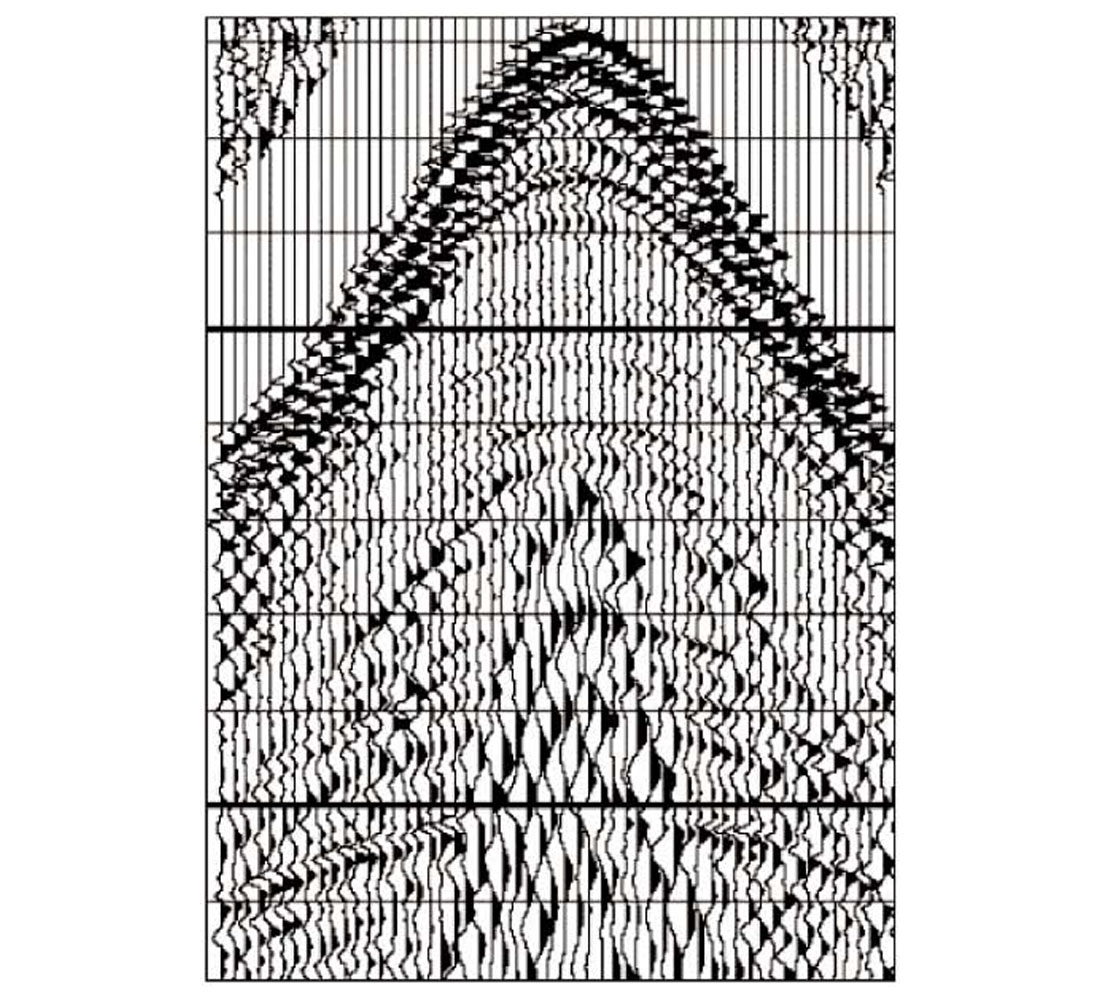
While the high altitude system examined had some unanticipated problems, all of these could be overcome relatively easily, and this helicopter weight drop systems may well be a desirable source for many different areas. We believe that a system could be developed that has almost no environmental impact, which would deliver data quality similar to current acquisition, at a similar cost. While the tests here are specifically aimed at problems in Canadian exploration, we believe that similar methods may be ideal for and environment where both access and drilling is difficult. This may include mountainous areas of the USA, or jungle regions of South America. We encourage others to experiment further with the ideas presented here.











Join the Conversation
Interested in starting, or contributing to a conversation about an article or issue of the RECORDER? Join our CSEG LinkedIn Group.
Share This Article